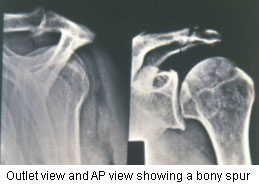About rotator cuff and shoulder impingement
The rotator cuff
The rotator cuff is formed by the tendinous portions of four muscles – the supraspinatus, infraspinatus, teres minor and the subscapularis which arise from the scapula (shoulder blade) and attach to the upper end of the humerus (arm bone).
The rotator cuff serves three important functions:
1. To move the arm in relation to the scapula
2. To stabilize the head of the humerus in the glenoid fossa socket
3. To achieve muscular balance (fine tuning) at the shoulder joint
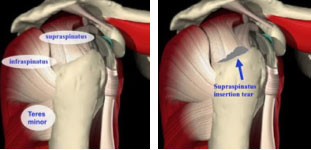
What is meant by shoulder impingement?
This is also known as Shoulder impingement syndrome, Painful arc syndrome or Mid-arc syndrome. Shoulder impingement is described as pain or discomfort felt by a patient on forward flexion of the arm (lifting the arm in the front of the body). This literally means that the rotator cuff gets pinched between the acromion and the upper end of humerus. Typically the pain begins when the arm is raised to about 60 degrees and continues until the arm reaches about 120 degrees. As the arm is moved beyond this point the pain disappears. Similarly, when the patient tries to lower the arm from a fully elevated (flexed) position, the pain appears at about 120 degrees and disappears when it reaches about 60 degrees. This is described as ‘mid-arc syndrome’ as the pain appears in the middle range of full flexion of 180 degrees.
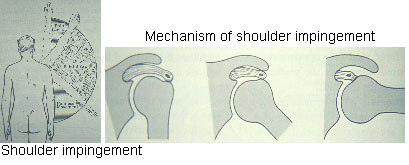
The presence of impingement merely points to the involvement of the rotator cuff as the cause of patient’s shoulder pain. It may be caused either due to rotator cuff tendinitis or a partial tear or full thickness tear of the rotator cuff.
What causes of shoulder impingement?
Impingement is caused whenever there is tendinitis (swelling) or tear (partial or full thickness) of the rotator cuff from whatever cause. This is known as Primary impingement. The causes are:
1. Degenerative cuff tears – this refers to weakening of the rotator cuff due to degeneration of ageing, which could lead to partial or full thickness tears and are seen in middle-aged and elderly patients.
2. Traumatic tears – this refers to tears caused due to a violent fall on the hand, and is seen in both young as well as old patients.
3. Calcific tendonitis tendinitis – this is due to deposition of calcium crystals in the rotator cuff which may cause tendonitis (inflammation) or tear.
4. Subacromial bursitis – inflammation of the subacromial bursa which lies under the acromion.
5. Bony spurs – these are bony outgrowths arising from under surface of the acromion or from an arthritic acromio-clavicular (AC) joint. These spurs can rub against the rotator cuff causing impingement.
Impingement can also be caused when the cuff is normal but gets impinged due to instability of the shoulder. This instability could be due to excessive stretching of the anterior capsule or the rotator cuff due to repetitive throwing motion as in throwing athletes. This is known as Secondary impingement.
How do you diagnose a patient with impingement and rotator cuff tear?
Diagnosis of a patient with impingement is made on the basis of patient’s symptoms, physical examination and investigations like X-rays, Ultrasonography and MRI scan.
Patients with primary impingement present with pain on the outer aspect of the shoulder especially on forward flexion (elevation of the arm in the front of the body). On examination these patients will have a positive impingement test (Neer’s and Hawkin’s test). They usually have some limitation of internal rotation (difficulty in getting the hand behind the patient’s back). They may have weakness of strength of rotator cuff muscles. Patients with secondary impingement due to associated instability of the shoulder will demonstrate a positive Apprehension test and Jobe’s relocation test. Patients with long-standing full thickness tears develop severe arthritic changes in shoulder and have marked pain, stiffness and severe disability. This is known as rotator cuff arthropathy.
Investigations for impingement and rotator cuff tears
1. Plain X-rays (AP and Outlet views): These may demonstrate a spur on the under surface of the acromion causing impingement. Reduction of the distance between the head of the humerus and acromion may indicate a full thickness rotator cuff tear. Patients with calcific tendinitis may show radiopaque shadow in the subacromial space suggestive of calcium deposition in the cuff. Patients with rotator cuff arthropathy will show a superiorly migrated humeral head with gross arthritic changes.
2. Ultrasongraphy (USG): This is useful in imaging rotator cuff tears. Its accuracy for diagnosing full thickness tears is high.
3. MRI scans and MR arthrograpghy: MRI remains the best imaging modality for rotator cuff dysfunction. It is a very sensitive test with high accuracy rates. It can distinguish between tendinitis, intra-substance tears, partial tears and full thickness tears. The addition of contrast arthrography further increases its accuracy.
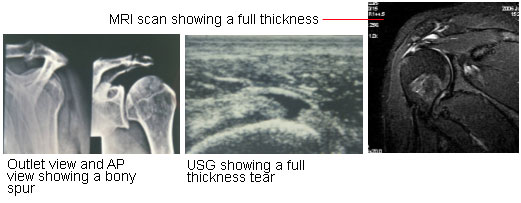
Treatment of shoulder impingement and rotator cuff tear
The treatment of impingement depends upon the cause of impingement (rotator cuff tendinitis or tear, subacromial bursitis, acromial spur or calcific tendonitis).Treatment modalities include rest, anti-inflammatory medication, physiotherapy, hydrocortisone injections,and surgery. Most patients with tendinitis and partial tears will respond to non-operative treatment.
1) Rest
This is particularly useful in patients with acute and severe pain. Once pain subsides patients should be encouraged to use their arm. Athletes may need gradual resumption of training activities.
2) Physiotherapy
his This includes modalities for relieving pain (heat treatment), stretching exercises (for stretching the tight posterior capsule), and exercises for strengthening the rotator cuff. Throwing athletes will need corrective measures to improve their throwing action.
3) Intra-articular injections
Injections These injections are given in the subacromial space (beneath the acromion). Injections These consist of injections of a Local anaesthetic (Xylocaine or Sensorcaine) and Hydrocortisone (steroid) are given either singly or as a combined injection. Steroid injections should be used judiciously as there is some concern about steroids causing weakening of the rotator cuff. Most surgeons agree that no more than 3 injections be given within a period of 12 months.
4) Surgery
This is reserved for patients who do not respond to the above treatment options. The surgical options include:
1. Acromioplasty (Subacromial decompression) – this involves removing the bony spur or prominence on the under surface of the acromion. Acromioplasty alone suffices if there is no cuff tear. This can be done arthoscopic or by open surgery. Arthroscopic surgery has the advantage of being minimally invasive, and causes lesser trauma to the deltoid muscle, and therefore allows faster recovery.

2. Rotator cuff repair – this involves repairing the torn rotator cuff back to the bone at its site of insertion on the humerus. Full thickness tears are re-attached back to bone using suture anchors. Partial thickness tears are usually treated with debridement (cleaning up of the torn surface) with a view to stimulate healing. Both these procedures may be done arthroscopic or by open surgery.
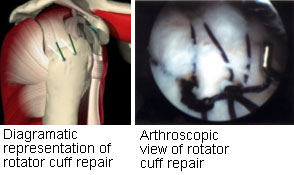
3. Tendon transfer – this is reserved for massive and irreparable tears. The latissimus dorsi tendon is detached from it insertion on the arm and re- routed to the greater tuberosity.
4. Total shoulder replacement – this is usually required in patients with rotator cuff arthropathy (severe arthritis due to long standing massive rotator cuff tear) with severe disability. Results using conventional total shoulder prosthesis are not very encouraging in patients with rotator cuff deficiency. The reverse shoulder arthroplasty has been shown to give good results in these patients.
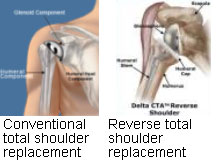
Post-operative rehabilitation after rotator cuff repair
Patients who have undergone a subacromial decompression alone (and where the rotator cuff is not torn) will have to use a shoulder sling for support for a period of 2-3 weeks. They are encouraged to move their arm almost immediately after the surgery to achieve range of motion in the shoulder, and are also shown exercises to regain strength in the shoulder. Patients who have undergone a rotator cuff repair will have their shoulder immobilized in a shoulder immobilizer type of a sling for a period of 4-6 weeks. During this all active movements of the shoulder are restricted. Patients are started on pendulum exercises (gentle range-of-motion exercises) at around 2-3 weeks after surgery, and full range of motion exercises and muscle strengthening exercises are started 6 weeks after surgery. Return to baseline activity may take up to 4-6 months after surgery.
Case Illustration:
This is an illustration of a lady 65 years of age with a full thickness tear of the rotator cuff. Illustration shows loss of active movement (inability to lift the arm in the front and the side). The picture on extreme right shows that passive movement (arm lifted by the examiner) is preserved.

